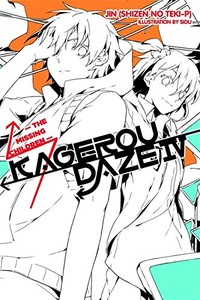Review
by Rebecca Silverman,Kagerou Daze
Novel 4 - The Missing Children
| Synopsis: |  |
||
A day after the events of the previous volume, Shintaro has a conversation with Marie that makes him wonder about her origins and all of Mekakushi-dan's powers. Where did they come from, and are they related? The group sets out to find Marie's childhood home and ends up stumbling upon more questions – and answers – than they had anticipated, as they solve the mysteries of the Kagerou Daze. |
|||
| Review: | |||
Kagerou Daze has the dubious distinction of being one of the most difficult light novels currently being published in English to follow. In part, this is due to the dense language of the first two books, although that thankfully has abated somewhat, but mostly it's because of author Jin's habit of not necessarily letting you know who's narrating at any given point. Presumably, we're meant to be able to tell by the characters' voices, but either Jin is not a good enough author to really give each player a distinct voice or the translation isn't quite cutting it (and this series consistently has more typographical errors than any other from YenOn). While this series unconsciously seeks to imitate the style of Virigina Woolf's The Waves, it really doesn't pull it off. The fourth book continues to be hampered by this issue, although it does improve in terms of the actual story, making it a mixed bag to read. This volume primarily gives us Marie's background and the origins of how the strange powers of Mekakushi-dan came to Japan in the first place. It's a much more traditional fantasy in that sense, involving supernatural creatures and a recognizable mythology, even if the beings that spawned Marie aren't named. The narrative shifts between “Reaper Record,” with a new character narrating, and “Children Record,” which is told in Shintaro's voice, with one “Headphone Actor” chapter at the end, which may or may not be welcome depending on whether you find Ene's voice grating. (One of the chief attractions of this volume is that Headphone Actor is the only part of the book involving Ene.) As I said before, there isn't much to distinguish the separate voices, giving the book a generic quality that detracts from the story, which in the case of “Reaper Record” is a shame, because this is one of the more intriguing plotlines in the series thus far. “Reaper Record” is also an easier story to follow than the convoluted tale of the Mekakushi-dan. Although it jumps around in time a fair amount, this is adequately explained by the nature of the narrator herself, and the story becomes important to understanding the larger picture that the series is attempting to establish. Marie's heritage and first years of life, although the latter is not fully explained, does provide quite a bit of information explaining her character, but more importantly, it delves more deeply into the question of multiple parallel realities, admitting that when someone appears to die in the “real” world, that might not necessarily be the case. While other novels have done this better – the introduction to the first Outlander book comes to mind – it still raises interesting potential answers to questions from the first three volumes while also hinting at what the ultimate endgame of the series might be. Less successful is the “Children Record,” which continues Shintaro's narration. His sections bring back the density of the first novel, although somewhat reduced as Jin has become a more confident writer. There is a tendency for these chapters to devolve into what I imagine is intended to represent an “otaku” mode of speech, with convoluted construction and tortured metaphors. The lack of Ene really does have a positive effect on Shintaro's narration, however, as he is considerably less obnoxious without her baiting him constantly. His interactions with the other characters do feel very superficial, which is another persistent series problem that we also see to a degree in the “Reaper Record” chapters, which robs the final scenes with Konoha of some of their impact. The most successful part of the novel comes from the way that words are placed on the page. In the final “Reaper Record” starting on page 118, the text and images begin to take turns telling the story, which forces Jin to reduce his word count dramatically. When he doesn't write like he's being paid by the word, the story takes on a much more intimate tone that becomes striking, and Sidu's art, which often doesn't do much to enhance the story, suddenly takes on a new significance. If the whole series could be done this way, it would be a stronger franchise – perhaps with a clearer lyrical link to the songs that form its backbone. All in all, Kagerou Daze has been improving since its first novel, but it still suffers from many of the same issues. This book does seem to be moving things in a more positive literary direction, so it could be that as the series continues on, the stories will continue to grow stronger. |
| Grade: | |||
|
Overall : C
Story : C
Art : C-
+ The story is stronger when text and images work together, “Reaper” chapters have a less dense writing style and more understandable continuity, origin of the title gets explained |
|||
| discuss this in the forum (2 posts) | | |||
| Production Info: | ||
|
Full encyclopedia details about Release information about |
||